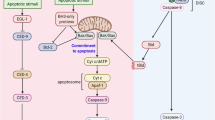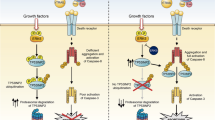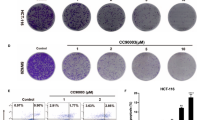Abstract
Stimulation of the Ras/MAPK cascade can either activate p53 and promote replicative senescence and apoptosis, or degrade p53 and promote cell survival. Here we show that p53 can directly counteract the Ras/MAPK signaling by inactivating ERK2/MAPK. This inactivation is due to a caspase cleavage of the ERK2 protein and contributes to p53-mediated growth arrest. We found that in Ras-transformed cells, growth arrest induced by p53, but not p21Waf1, is associated with a strong reduction in ERK2 activity, phosphorylation, and protein half-life, and with the appearance of caspase activity. Likewise, DNA damage-induced cell cycle arrest correlates with p53-dependent ERK2 downregulation and caspase activation. Furthermore, caspase inhibitors or expression of a caspase-resistant ERK2 mutant interfere with ERK2 cleavage and restore proliferation in the presence of p53 activation, indicating that caspase-mediated ERK2 degradation contributes to p53-induced growth arrest. These findings strongly point to ERK2 as a novel p53 target in growth suppression.
Similar content being viewed by others
Log in or create a free account to read this content
Gain free access to this article, as well as selected content from this journal and more on nature.com
or
Abbreviations
- Ad:
-
adenovirus
- ADR:
-
adriamycin
- dnp53:
-
dominant-negative p53
- LMB:
-
leptomycin B
- MBP:
-
myelin basic protein
- m.o.i.:
-
multiplicity of infection
- p.i.:
-
postinfection
- PI:
-
propidium iodide
- TCE:
-
total cell extract
- WB:
-
Western blotting
References
Lewis TS, Shapiro PS and Ahn NG (1998) Signal transduction through MAP kinase cascades. Adv. Cancer Res. 74: 49–139
Marshall CJ (1995) Specificity of receptor tyrosine kinase signaling: transient versus sustained extracellular signal-regulated kinase activation. Cell 80: 179–185
Cowley S, Paterson H, Kemp P and Marshall CJ (1994) Activation of MAP kinase kinase is necessary and sufficient for PC12 differentiation and for transformation of NIH 3T3 cells. Cell 77: 841–852
Lin AW, Barradas M, Stone JC, van Aelst L, Serrano M and Lowe SW (1998) Premature senescence involving p53 and p16 is activated in response to constitutive MEK/MAPK mitogenic signaling. Genes Dev. 12: 3008–3019
Ries S, Biederer C, Woods D, Shifman O, Shirasawa S, Sasazuki T, McMahon M, Oren M and McCormick F (2000) Opposing effects of Ras on p53: transcriptional activation of mdm2 and induction of p19ARF. Cell 103: 321–330
Serrano M, Lin AW, McCurrach ME, Beach D and Lowe SW (1997) Oncogenic ras provokes premature cell senescence associated with accumulation of p53 and p16INK4a. Cell 88: 593–602
Lowe SW (1999) Activation of p53 by oncogenes. Endocr. Relat. Cancer 6: 45–48
Lee SW, Fang L, Igarashi M, Ouchi T, Lu KP and Aaronson SA (2000) Sustained activation of Ras/Raf/mitogen-activated protein kinase cascade by the tumor suppressor p53. Proc. Natl. Acad. Sci. USA 97: 8302–8305
Deguin-Chambon V, Vacher M, Jullien M, May E and Bourdon J-C (2000) Direct transactivation of c-Ha-ras gene by p53: evidence for its involvement in p53 transactivation activity and p53-mediated apoptosis. Oncogene 19: 5831–5841
Peeper DS, Upton TM, Ladha MH, Neuman E, Zalvide J, Bernards R, DeCaprio JA and Ewen ME (1997) Ras signalling linked to the cell-cycle machinery by the retinoblastoma protein. Nature 386: 177–181
Bates S, Phillis AC, Clark PA, Stott F, Peters G, Ludwig RL and Vousden KH (1998) p14ARF links the tumour suppressors RB and p53. Nature 395: 124–125
Sherr CJ and Weber JD (2000) The ARF/p53 pathway. Curr. Opin. Genet. Dev. 10: 94–99
Pearson M, Carbone R, Sebastiani C, Cioce M, Fagioli M, Saito S, Higashimoto Y, Appella E, Minucci S, Pandolfi PP and Pelicci PG (2000) PML regulates p53 acetylation and premature senescence induced by oncogenic Ras. Nature 406: 207–210
Wang X, Martindale JL and Holbrook NJ (2000) Requirement for ERK activation in cisplatin-induced apoptosis. J. Biol. Chem. 275: 39435–39443
Manni I, Mazzaro G, Gurtner A, Mantovani R, Haugwitz U, Krause K, Engeland K, Sacchi A, Soddu S and Piaggio G (2001) NF-Y mediates the transcriptional inhibition of the cyclin B1, cyclin B2, and cdc25C promoters upon induced G2 arrest. J. Biol. Chem. 276: 5570–5576
Fukuda M, Asano S, Nakamura T, Adachi M, Yoshida M, Yanagida M and Nishida E (1997) CRM1 is responsible for intracellular transport mediated by the nuclear export signal. Nature 390: 308–311
Freedman DA and Levine AJ (1998) Nuclear export is required for degradation of endogenous p53 by MDM2 and human papillomavirus E6. Mol. Cell. Biol. 18: 7288–7293
Smart P, Lane EB, Lane DP, Midgley C, Vojtesek B and Laìn S (1999) Effects on normal fibroblasts and neuroblastoma cells of the activation of the p53 response by the nuclear export inhibitor leptomycin B. Oncogene 18: 7378–7386
Innocente SA, Abrahamson JL, Cogswell JP and Lee JM (1999) p53 regulates a G2 checkpoint through cyclin B1. Proc. Natl. Acad. Sci. USA 96: 2147–2152
El-Deiry WS, Tokino T, Velculescu VE, Levy DB, Parsons R, Trent JM, Lin D, Mercer WE, Kinzler KW and Vogelstein B (1993) WAF1, a potential mediator of p53 tumor suppression. Cell 75: 817–825
Gottlieb E and Oren M (1998) p53 facilitates pRb cleavage in IL-3-deprived cells: novel pro-apoptotic activity of p53. EMBO J. 17: 3587–3596
Bachelder RE, Ribick MJ, Marchetti A, Falcioni R, Soddu S, Davis KR and Mercurio AM (1999) p53 inhibits α6β4 integrin signaling by promoting the caspase 3-dependent cleavage of AKT/PKB. J. Cell Biol. 147: 1063–1072
De Maria R, Zeuner A, Eramo A, Domenichelli C, Bonc, D, Grignani F, Srinivasula SM, Alnemri ES, Testa U and Peschle C (1999) Negative regulation of erythropoiesis by caspase-mediated cleavage of GATA-1. Nature 401: 489–493
Cohen GM (1997) Caspases: the executioners of apoptosis. Biochem. J. 326: 1–16
Brummelkamp TR, Bernards R and Agami R (2002) A system for stable expression of short interfering RNAs in mammalian cells. Science 296: 550–553
Ko LJ and Prives C (1996) p53: puzzle and paradigm. Genes Dev. 10: 1054–1072
Vousden KH (2000) p53: death star. Cell 103: 691–694
Dasika GK, Lin SC, Zhao S, Sung P, Tomkinson A and Lee EY (1999) DNA-damage-induced cell cycle checkpoints and DNA strand break repair in development and tumorigenesis. Oncogene 18: 7883–7899
Wrigth JH, Munar E, Jameson DR, Andreassen PR, Margolis RL, Seger R and Krebs EG (1999) Mitogen-activated protein kinase activity is required for the G2/M transition of the cell cycle in mammalian fibroblasts. Proc. Natl. Acad. Sci. USA 96: 11335–11340
Hitomi M and Stacey DW (2001) Ras-dependent cell cycle commitment during G2 phase. FEBS Lett. 490: 123–131
D'Orazi G, Soddu S and Sacchi A (2000) Activation of p53/p21waf1 pathway is associated with senescence during v-Ha-ras transformation of immortal C2C12 myoblasts. Anticancer Res. 20: 3497–3502
Widmann C, Gibson S and Johnson GL (1998) Caspase-dependent cleavage of signaling proteins during apoptosis. J. Biol. Chem. 273: 7141–7147
Pochampally R, Fodera B, Chen L, Shao W, Levine EA and Chen J (1998) A 60 kD MDM2 isoform is produced by caspase cleavage in non-apoptotic tumor cells. Oncogene 17: 2629–2636
Gentiletti F, Mancini F, D'Angelo M, Sacchi A, Pontecorvi A, Jochemsen AG and Moretti F (2002) MDMX stability is regulated by p53-induced caspase cleavage in NIH-3T3 mouse fibroblasts. Oncogene 21: 867–877
Fang L, Li G, Liu G, Lee SW and Aaronson SA (2001) p53 induction of heparin-binding EGF-like growth factor counteracts p53 growth suppression through activation of MAPK and PI3K/Akt signaling cascades. EMBO J. 20: 1931–1939
Sabbatini P and McCormick F (1999) Phosphoinositide 3-OH kinase (PI3K) and PKB/Akt delay the onset of p53-mediated, transcriptionally dependent apoptosis. J. Biol. Chem. 274: 24263–24269
Kinzler KW and Vogelstein B (1996) Lessons from hereditary colorectal cancer. Cell 87: 159–170
D'Orazi G, Marchetti A, Crescenzi M, Coen S, Sacchi A and Soddu S (2000) Exogenous wt-p53 protein is active in transformed cells but not in their non-transformed counterparts: implications for cancer gene therapy without tumor targeting. J. Gene Med. 2: 11–21
Del Bufalo D, Cucco C, Leonetti C, Citro G, Dagnano I, Benassi M, Geiser T, Zon G, Calabretta B and Zupi G (1996) Effect of cisplatin and c-myb antisense phosphorothioate oligodeoxynucleotides combination on a human colon carcinoma cell line in vitro and in vivo. Br. J. Cancer 74: 387–393
Graham F and Prevec L (1991) Manipulation of adenovirus. In Methods of Molecular Biology, Murray EJ, ed (Clifton, NJ: Humana Press) Vol. 7, pp. 109–128
Agami R, Blandino G, Oren M and Shaul Y (1999) Interaction of c-Abl and p73alpha and their collaboration to induce apoptosis. Nature 399: 809–813
Morgenstern JP and Land H (1990) Advanced mammalian gene transfer: high titre retroviral vectors with multiple drug selection markers and a complementary helper-free packaging cell line. Nucleic Acids Res. 18: 3587–3596
Shaulian E, Zauberman A, Ginsberg D and Oren M (1992) Identification of a minimal transforming domain of p53: negative dominance through abrogation of sequence-specific DNA binding. Mol. Cell. Biol. 12: 5581–5592
Acknowledgements
This paper is dedicated to the memory of Franco Tatò, maestro of science and humanity. We thank him for all he gave us. We thank all the people cited in the text for their generous gifts of reagents. We are grateful to F Moretti, A Zeuner, and R De Maria for helpful advice and discussion on the caspase work, to S Bacchetti for her comments on the manuscript, and to S Iacovelli for technical support. This study was supported by Associazione Italiana per la Ricerca sul Cancro and Ministero della Salute. The authors declare that they have no competing financial interests.
Author information
Authors and Affiliations
Corresponding author
Additional information
Edited by G Melino
Supplementary Information accompanies the paper on Cell Death and Differentiation website (http://www.nature.com/cdd).
Supplementary information
Rights and permissions
About this article
Cite this article
Marchetti, A., Cecchinelli, B., D'Angelo, M. et al. p53 can inhibit cell proliferation through caspase-mediated cleavage of ERK2/MAPK. Cell Death Differ 11, 596–607 (2004). https://doi.org/10.1038/sj.cdd.4401368
Received:
Revised:
Accepted:
Published:
Issue date:
DOI: https://doi.org/10.1038/sj.cdd.4401368
Keywords
This article is cited by
-
Involvement of Mitogen-Activated Protein Kinase Pathway in T-2 Toxin-Induced Cell Cycle Alteration and Apoptosis in Human Neuroblastoma Cells
Molecular Neurobiology (2015)
-
Control of gp130 expression by the mitogen-activated protein kinase ERK2
Oncogene (2014)
-
Something old, something new and something borrowed: emerging paradigm of insulin-like growth factor type 1 receptor (IGF-1R) signaling regulation
Cellular and Molecular Life Sciences (2014)
-
Updates on HIPK2: a resourceful oncosuppressor for clearing cancer
Journal of Experimental & Clinical Cancer Research (2012)
-
Modulatory effect of phytoglycoprotein (38 kDa) on cyclin D1/CDK4 in BNL CL.2 cells induced by N-methyl-N′-nitro-N-nitrosoguanidine
Naunyn-Schmiedeberg's Archives of Pharmacology (2012)



